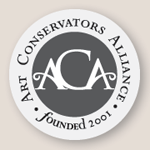
If possible, it is always best to interact directly with the art conservator who will be doing the work. Know the name and credentials of the person, or persons, who will be working on a treasured art object or artifact. When you make an appointment with the art conservator to discuss your art object’s needs, be sure to express your expectations and goals for the treatment. The art conservator should be aware of your priorities and will endeavor to make clear how they are best achieved through conservation treatment, restoration procedures, and/or preservation practices. Professional art conservators provide clients with detailed written information about their artworks, and apply the highest ethical standards towards treatment design that balances reversibility with stability according to the condition and context of each item.
Things to ask the art conservator:
- Request a list of the art conservator’s previous clients and contact them.
- Elicit information regarding the art conservator’s background, formal education, training, professional affiliations, and experience in treating other objects like your treasured artifact. There are master’s degree programs in art conservation in the United States, Canada and Europe with comprehensive studies in studio art, art history, and chemistry, preparing art conservators to make the best informed decisions about protecting and preserving your art or artifact.
- Find out if the art conservator is a member of the national professional organization, The American Institute for Conservation of Historic & Artistic Works (AIC). AIC has professional membership levels based on professional experience and a Code of Ethics and Guidelines for Practice. Documentation of the condition and treatment with permanent records and written reports are required of AIC professional members and should be standard practice for anyone working on artifacts.
Expect to receive the following from a professional art conservator:
- a Condition Report and Treatment Proposal with an evaluation of your artifact’s condition, a recommendation for treatment, and an estimate of the treatment cost
-
notification during treatment if any major changes to the proposed treatment are found to be necessary
- a Treatment Report describing the steps and materials used in the conservation treatment. The conservator will have photographic documentation of the object before and after treatment available upon request
For more information visit the American Institute for Conservation's "Guidelines for Selecting a Conservator".
|
 |


